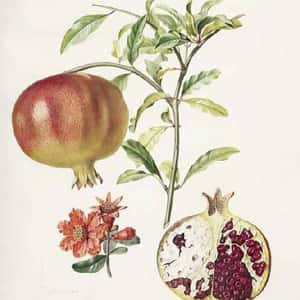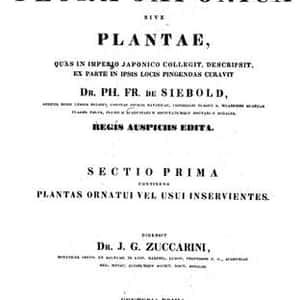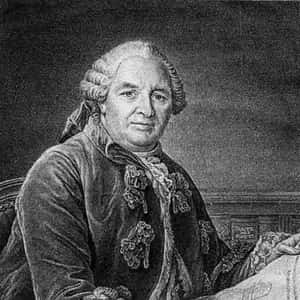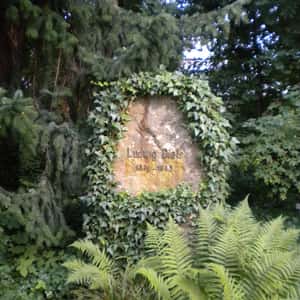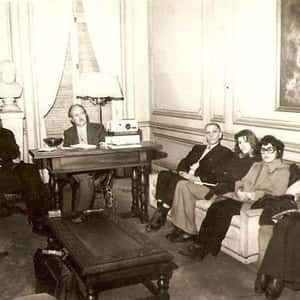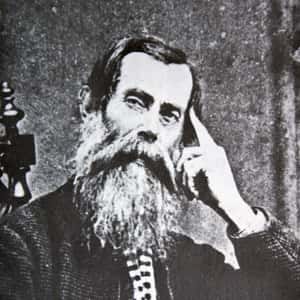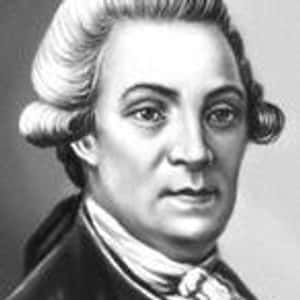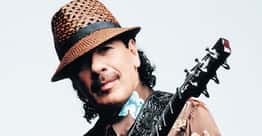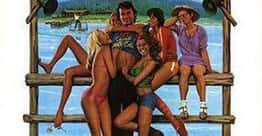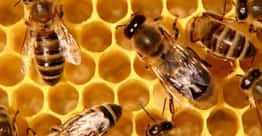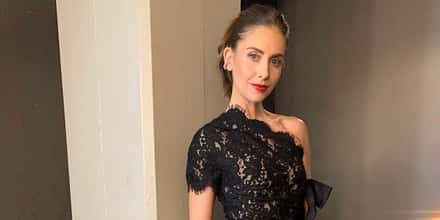Rupert Charles Barneby
Dec. at 89 (1911-2000)Rupert Charles Barneby (6 October 1911 – 5 December 2000) was a British-born self-taught botanist whose primary specialty was the Fabaceae (Leguminosae), the pea family, but he also worked on Menispermaceae and numerous other groups. He was employed by the New York Botanical Garden from the 1950s until shortly before his death. Barneby published prolifically and named and described over 1,100 new species. In addition, he had 25 species named after him as well as four genera: Barnebya, Barnebyella, Barnebydendron, and Rupertia. He received numerous prestigious botanical awards, including The New York Botanical Garden's Henry Allan Gleason Award (1980), the American Society of Plant Taxonomists' Asa Gray Award (1989), the International Association for Plant Taxonomy's Engler Silver Medal (1992), and the International Botanical Congress's Millennium Botany Award (1999). His lifelong partner was Harry Dwight Dillon Ripley (1908–1973). PublicationsBarneby, Rupert (1964). "Atlas of North American Astragalus". The Memoirs of the New York Botanical Garden. v.13 (pt.1). Barneby, Rupert (1964). "Atlas of North American Astragalus". The Memoirs of the New York Botanical Garden. 13) (pt.2). Barneby, Rupert (1977). "Daleae imagines". The Memoirs of the New York Botanical Garden. 27). Barneby, Rupert; Irwin, Howard S. (1978). "Monographic studies in Cassia (Leguminosae, Caesalpinioideae)". Barneby, Rupert; Irwin, Howard S. (1982). "The American Cassiinae". The Memoirs of the New York Botanical Garden. v.35 (pt.1). Barneby, Rupert; Irwin, Howard S. (1982). "The American Cassiinae". The Memoirs of the New York Botanical Garden. v.35 (pt.2). Barneby, Rupert (1991). "Sensitivae censitae: description of the genus Mimosa Linnaeus (Mimosaceae) in the New World". The Memoirs of the New York Botanical Garden. v.65. Barneby, Rupert; Grimes, James W. (1996). "Silk tree, guanacaste, monkey's earring : a generic system for the synandrous Mimosaceae of the Americas". The Memoirs of the New York Botanical Garden. v.74 (pt.1). Barneby, Rupert; Grimes, James W. (1997). "Silk tree, guanacaste, monkey's earring : a generic system for the synandrous Mimosaceae of the Americas". The Memoirs of the New York Botanical Garden. v.74 (pt.2). Barneby, Rupert; Grimes, James W. (1998). "Silk tree, guanacaste, monkey's earring : a generic system for the synandrous Mimosaceae of the Americas". The Memoirs of the New York Botanical Garden. v.74 (pt.3).Hermann Müller
Dec. at 76 (1850-1927)For other Hermann Müllers: see Hermann Müller (disambiguation). Hermann Müller (21 October 1850 in Tägerwilen, Thurgau, Switzerland – 18 January 1927, in Wädenswil, Zurich), was a Swiss botanist, plant physiologist, oenologist and grape breeder. He called himself Müller-Thurgau, taking the name of his home canton.- Dec. at 72 (1799-1871)Anna Atkins (née Children; 16 March 1799 – 9 June 1871) was an English botanist and photographer. She is often considered the first person to publish a book illustrated with photographic images. Some sources claim that she was the first woman to create a photograph.
John M. MacDougal
Age: 70John Mochrie MacDougal (born 1954) is an American botanist, noted for his work on the taxonomy of passion flowers, having discovered several new species. He earned his Bachelor of Science in 1975 at College of Charleston. In 1984 he earned his doctorate at Duke University. Between 1984 and 1986 he was visiting assistant professor of biology at the North Carolina Agricultural and Technical State University. Between 1987 and 1989 he was postdoctoral researcher at the Flora Mesoamerica project at the Missouri Botanical Garden in St. Louis, Missouri. Between 1990 and 2002 he was conservatory manager at the Missouri Botanical Garden. MacDougal has written more than fifty peer reviewed articles and book chapters. Currently, he is an assistant professor of biology at Harris-Stowe State University. James Mallet and Sandra Knapp have named Passiflora macdougaliana after him.Carl Bolle
Dec. at 87 (1821-1909)Carl August Bolle (21 November 1821, Schöneberg (Berlin) – 17 February 1909) was a German naturalist and collector. Bolle was born at Berlin into a wealthy brewing family. He studied medicine and natural science at Berlin and Bonn. He visited the Cape Verde Islands and the Canary Islands in 1852 and 1856, and wrote Mein zweiter Beitrag zur Vogelkunde der Canarischen Inseln in 1857.Bolle was a founder member of the Deutsche Ornithologen-Gesellschaft (German Ornithological Society) in 1867, succeeding Alfred Brehm as Chairman in 1884. The Bolle's laurel pigeon (Columba bollii) of the Canary Islands was named after him by Frederick DuCane Godman. He also made contributions as a botanist, especially in the field of dendrology. His herbarium was bequeathed to the Berlin-Dahlem Botanical Garden and Botanical Museum, although largely destroyed during World War II (1943). The plant genus Bollea (family Orchidaceae) was named in his honor, but is now called Pescatoria.- Dec. at 51 (1742-1793)Jean Baptiste François Pierre Bulliard (also Pierre Bulliard, 24 November 1752 Aubepierre-sur-Aube Haute-Marne – 26 September 1793 Paris) was a French physician and botanist. The standard author abbreviation Bull. is used to indicate this person as the author when citing a botanical name.Bulliard studied in Langres, afterwards in Clairvaux and in Paris. There he also practiced as a physician. He tutored the son of General Claude Dupin (1686-1769). Bulliard’s Dictionnaire Elémentaire de Botanique (1783) contributed to the spreading and consolidation of botanical terminology and the Linné system. It was especially important in the area of the mycology, containing descriptions of 393 out of 602 table mushrooms. Significant species he described include the cep (Boletus edulis), the common inkcap (Coprinopsis atramentaria) and the poisonous livid pinkgill (Entoloma sinuatum)
Pierre Jean François Turpin
Dec. at 65 (1775-1840)Pierre Jean François Turpin (11 March 1775, Vire – 1 May 1840) was a French botanist and illustrator. He is considered one of the greatest floral and botanical illustrators during the Napoleonic Era and afterwards. As an artist, Turpin was largely self-taught. In 1794 he was stationed in Haiti as a member of the French Army. Here he met botanist Pierre Antoine Poiteau (1766-1854), through whom, Turpin learned botany, and in the meantime, created numerous botanical field drawings that were to become a basis of further study when the two men returned to France. In regard to their work in Haiti, they were able to describe approximately 800 species of plants. Turpin would have a working relationship with Poiteau throughout his career. Through his collaboration with Poiteau and other naturalists, Turpin created some of the finest watercolors and illustrations of plants that are known to exist. The following are some of the works making use of Turpin's illustrations: Augustin Saint-Hilaire's Flora Brasiliae Meridionalis in three volumes (1825–1832) Jules Paul Benjamin Delessert's (1773-1847) Icones selectae plantarum. With Pierre Poiteau, he produced an updated version of Henri Louis Duhamel du Monceau's (1700-1782) Traité des arbres fruitiers (treatise on fruit trees). Alexander von Humboldt (1769-1859) and Aimé Bonpland's (1773-1858) Plantes Equinoxales (1808). Jean Louis Marie Poiret's (1755-1834) Leçons de flore: Cours complet de botanique (1819-1820). François-Pierre Chaumeton's (1775-1819) Flore médicale (1828-1832).In 1833 he was elected as a member to the Académie des sciences. The plant genus Turpinia is named in his honour.Joseph Gerhard Zuccarini
Dec. at 50 (1797-1848)Joseph Gerhard Zuccarini (10 August 1797 – 18 February 1848) was a German botanist, Professor of Botany at the University of Munich. He worked extensively with Philipp Franz von Siebold, assisting in describing his collections from Japan, but also described plants discovered in other areas, including Mexico. Siebold wrote his Flora Japonica in collaboration with Zuccarini. It first appeared in 1835, but the work was not completed until after his death, finished in 1870 by F. A. W. Miquel (1811–1871), director of the Rijksherbarium in Leiden. The botanical genus Zuccarinia (Rubiaceae) was named in his honor by Carl Ludwig Blume in 1827.Henri-Louis Duhamel du Monceau
Dec. at 82 (1700-1782)Henri-Louis Duhamel du Monceau (20 July 1700, Paris – 13 August 1782, Paris), was a French physician, naval engineer and botanist.Ludwig Diels
Dec. at 71 (1874-1945)Dr. Friedrich Ludwig Emil Diels (24 September 1874 – 30 November 1945), was a German botanist. Diels was born in Hamburg, the son of the classical scholar Hermann Alexander Diels. From 1900 to 1902 he traveled together with Ernst Georg Pritzel through South Africa, Java, Australia and New Zealand.Shortly before the first world war he travelled New Guinea and in the 1930s in Ecuador. Especially his collections of plants from Australia and Ecuador, which contained numerous holotypes, enriched the knowledge of the concerning floras. His monography on the Droseraceae from 1906 is still a standard. The majority of his collections were stored at the botanical garden in Berlin-Dahlem, whose vicedirector he had been since 1913, becoming its director in 1921 until 1945. His collections were destroyed there during an air raid in 1943. He died in Berlin.Lilian Gibbs
Dec. at 54 (1870-1925)Lilian Suzette Gibbs (1870–1925) was a British botanist who worked for the British Museum in London. She was the first woman and the first botanist to ascend Mount Kinabalu in February 1910. Gibbs collected many plants new to science, several of which are named in her honour (e.g. Racemobambos gibbsiae or Miss Gibbs' Bamboo).Hermann Otto Sleumer
Dec. at 87 (1906-1993)Hermann Otto Sleumer (February 21, 1906 in Saarbrücken – October 1, 1993 in Oegstgeest) was a Dutch botanist of German birth. The plant genera Sleumerodendron Virot (Proteaceae) and Sleumeria Utteridge, Nagam. & Teo (Icacinaceae), are named for him.Frederik Liebmann
Dec. at 43 (1813-1856)Frederik Michael Liebmann (10 October 1813 – 29 October 1856) was a Danish botanist. Liebmann studied botany at the University of Copenhagen, although he never obtained a formal qualification. He went on study tours of Germany and Norway before becoming lecturer at the Danish Royal Veterinary School in 1837. In 1840 he travelled to Cuba and Mexico; on his return in 1845 he was appointed Professor of Botany at the University of Copenhagen. He became Director of the university's Botanical Garden in 1852, a post he held until his death four years later. He was the editor of Flora Danica and issued fasc. 41-43 (1845–1852) and Supplement vol. 1, a total of 240 plates.Hermann Harms
Dec. at 72 (1870-1942)Hermann August Theodor Harms (16 July 1870, in Berlin – 27 November 1942, in Berlin) was a German taxonomist and botanist. Harms worked as a botanist at the Botanical Museum in Berlin. He was a member of the Prussian Academy of Sciences. He was longtime editor of Adolf Engler's "Das Pflanzenreich", and was the author of several chapters on various plant families in Engler and Prantl's "Die Natürlichen Pflanzenfamilien", including the chapters on Bromeliaceae (1930) and Nepenthaceae (1936). In the latter he revised the pitcher plant genus Nepenthes, dividing it into three subgenera: Anurosperma, Eunepenthes and Mesonepenthes (see Taxonomy of Nepenthes). Furthermore, he was interested in the genus Passiflora. The plant genera Harmsia (Schum.) and Harmsiella (Briq.) commemorate his name.Selmar Schonland
Dec. at 79 (1860-1940)Selmar Schonland (15 August 1860 – 22 April 1940), the founder of the Department of Botany at Rhodes University, was a German immigrant, who came to the Eastern part of the Cape Colony in 1889 to take up an appointment as curator of the Albany Museum. He came to Grahamstown via a doctorate at the University of Hamburg and a post at Oxford University (1886–1889 as curator of the Fielding Herbarium and a lecturer in Botany). Working under Prof. Sir Isaac Bayley Balfour and Prof. Sydney Howard Vines, he developed an interest in the family Crassulaceae and contributed an account of this group to Engler & Prantl's Natürl. Pflanzenfamilien. Coming to the museum in Grahamstown gave him the opportunity to broaden his interests and develop the second largest herbarium in South Africa which had been founded by W. G. Atherstone in 1860. His father-in-law, Peter MacOwan, had been its honorary curator from 1862 to 1869 before moving to Somerset East. When MacOwan retired from his subsequent post as director of the Cape Town Botanical Garden and curator of the Cape Government Herbarium, he returned to Grahamstown and assisted Schonland in the development of the local herbarium. The Irish descendant Henry George Flanagan of the Eastern Cape contributed to this Herbarium with specimens, both in Grahamstown and in Cape Town. Schonland approached one of the Rhodes Trustees, Dr. Leander Starr Jameson to assist in funding. Jameson, soon to be elected Member of Parliament for Albany and Prime Minister of the Cape Colony, promised £50,000 without consulting his fellow Trustees. At first they refused to confirm the grant; then, persuaded by Schonland, they made over De Beers Preference Shares to the value of £50 000 to Rhodes University College, founded by Act of Parliament on May 31, 1904. By the time Schonland retired, the Botany Department and Rhodes University had become an established centre of taxonomic research and learning in South Africa. He played a leading role in the Botanical Survey of South Africa which had been initiated by Pole Evans. He was a foundation member of the South African Association for the Advancement of Science, honorary member of the Geological Society of South Africa, foundation member and Fellow of the Royal Soc. of S. Afr. His name was originally spelt Schönland, but he later dropped the umlaut. He is commemorated in Schoenlandia L.Bol., Euphorbia schoenlandii Pax, Brachystelma schonlandianum Schltr. and Sebaea schoenlandii Schinz. Selmar Schonland married Peter MacOwan's daughter Flora in 1896 and was the father of Sir Basil Schonland who contributed greatly to lightning research and radar development.Josef August Schultes
Dec. at 58 (1773-1831)Josef (Joseph) August Schultes (15 April 1773 in Vienna – 21 April 1831 in Landshut) was an Austrian botanist and professor from Vienna. Together with Johann Jacob Roemer (1763–1819), he published the 16th edition of Linnaeus' Systema Vegetabilium. In 1821, he was elected a foreign member of the Royal Swedish Academy of Sciences. He was the father of Julius Hermann Schultes (1804-1840). In 1796 he received his doctorate at Vienna, where he was a student of Johann Peter Frank (1745-1821). Later on, he served as a professor of botany and natural history at the Theresianum in Vienna, followed by professorships at the Universities of Krakow (1806) and Innsbruck (1808). In 1809 he succeeded Franz von Paula Schrank (1747-1835) at the University of Landshut as a professor of natural history and botany. At Landshut, he also served as a medical director. Swedish botanist Carl Peter Thunberg commissioned Schultes to edit the first complete edition of his Flora Capensis, which was published in 1823.- Dec. at 56 (1634-1691)Paul Amman (31 August 1634 – 4 February 1691), German physician and botanist.
Aleksander Zawadzki
Dec. at 70 (1798-1868)Aleksander Zawadzki, born Józef Antoni Zawadzki, (6 May 1798 in Bielitz, Austrian Silesia – 5 June 1868 in Brno) was a Polish naturalist, author of flora and fauna lists of the Galicia region and the neighbourhood of Lviv (Polish: Lwów). He was also the first scientist who studied and catalogued the beetles and butterflies of Eastern Galicia.Hugo Gunckel Lüer
Dec. at 95 (1901-1997)Hugo Gunckel Lüer (August 10, 1901 – July 17, 1997) was a Chilean pharmacist, botanist, and university professor. Gunckel is the ICBN author citation corresponding to Hugo Gunckel.Wilhelm Gueinzius
Dec. at 60 (1813-1874)Wilhelm Gueinzius (15 March 1813 – 24 January 1874) was a German naturalist, collector and apothecary.Richard Anthony Salisbury
Dec. at 67 (1761-1829)Richard Anthony Salisbury, FRS (born Richard Anthony Markham; 2 May 1761 – 23 March 1829) was a British botanist. While he carried out valuable work in horticultural and botanical sciences, several bitter disputes caused him to be ostracised by his contemporaries.Franz Sieber
Dec. at 55 (1789-1844)Franz Wilhelm Sieber (30 March 1789 – 17 December 1844), was a botanist and collector who travelled to Europe, the Middle East, Southern Africa and Australia.Jean Senebier
Dec. at 67 (1742-1809)Jean Senebier (May 6 or 25, 1742 – July 22, 1809) was a Genevan Calvinist pastor and naturalist. He was born in Geneva, the son of a wealthy merchant. He wrote extensively on plant physiology and was one of the major early pioneers of photosynthesis research. Senebier also published on the experimental method, first in 1775, and then in an expanded work, in 1802. His precise definition of the experimental method anticipated the work of noted French physiologist Claude Bernard fifty years later. Senebier also served as chief librarian of the Republic of Geneva.Senebier was greatly influenced by Swiss naturalist Charles Bonnet. Senebier was also influenced by the Italian animal physiologist and experimental biologist Lazzaro Spallanzani, several of whose works Senebier translated from Italian into French. Spallanzani's chemical research on bodily functions of animals helped lead Senebier towards studying plant chemistry. Although Senebier's first research on plants was a large study on effects of light, he is remembered mainly for the extensive evidence he provided that carbon dioxide ("fixed air" or "carbonic acid," in the terminology of his day) is consumed by plants in the production of oxygen ("dephlogisticated air"), in the physiological process that later became known as photosynthesis. Senebier also found that the amount of oxygen produced is roughly proportional to the amount of carbon dioxide available to the plant. Further, he determined that the green fleshy parts of leaves (the parenchyma) are the sites where carbon dioxide is transformed into oxygen. Senebier also correctly concluded that plants use the carbon in carbon dioxide as a nutriment. Senebier did some of his research jointly with fellow Swiss naturalist François Huber. Senebier arrived at his best known achievement, his demonstration that plants take up atmospheric carbon dioxide and give off oxygen, based entirely on the phlogiston theory of chemistry, and only in his later works did he reformulate his conclusions in terms of the more modern, oxygen chemistry developed by Antoine Lavoisier and colleagues. This discovery by Senebier regarding gases ranks as one of the last of the important early discoveries in the unraveling of the fundamental chemical processes of photosynthesis. Marcello Malpighi and Nehemiah Grew, working independently in the late seventeenth century, and Stephen Hales in the early eighteenth century, had provided evidence that the atmosphere was important to plants, but further progress in understanding the role of gases in plant physiology awaited discoveries made between 1750 and 1780. In 1754, Charles Bonnet reported that leaves that were plunged in aerated water produced bubbles of gas, but he did not identify the gas. Then, in 1775, English chemist Joseph Priestley discovered oxygen (which he named "dephlogisticated air"), and, just a few years later, in 1779, Dutch physician and researcher Jan Ingen-Housz demonstrated that the bubbles of gas observed by Bonnet on submerged leaves consisted of this same gas. Ingen-Housz also published the first convincing evidence that leaves produce this gas only in sunlight.Senebier was a close friend of noted Genevan geologist and meteorologist Horace-Bénédict de Saussure and was instrumental in the education of Horace-Bénédict's son Nicolas-Théodore de Saussure. Senebier trained the young man in Lavoisier's system of chemistry, which Nicolas-Théodore later applied in important plant-nutrition studies of his own. The younger Saussure would eventually discover the role of water in photosynthesis, thus completing the early chemical research on this subject.In April 1809, Senebier became a Correspondent of the Royal Netherlands Academy of Arts and Sciences.For more detailed information on Senebier, see Kottler and Nash.The standard botanical author abbreviation Seneb. is applied to species Senebier described.Louis Antoine François Baillon
Dec. at 73 (1778-1851)Louis Antoine François Baillon (20 January 1778 – 3 December 1855) was a French naturalist and collector. He was born in Montreuil-sur-Mer and died in Abbeville. His father, Jean-François-Emmanuel Baillon (1742-1801), a lawyer and correspondent of the Muséum national d'histoire naturelle, introduced him to natural history. In 1798, Baillon began work at as an assistant at the Jardin des Plantes, a position he relinquished following the death of his father. Afterwards, he settled in Abbeville, and like his father, became known for his correspondence with famed naturalists. In his studies, the younger Baillon maintained correspondence with Franco Andrea Bonelli, Étienne Geoffroy Saint-Hilaire and Prince Maximilian of Wied-Neuwied.During his career, he continued and developed an ornithological collection that was initiated by his father, a collection that eventually grew to 6000 items. Baillon's collection (birds only) is now conserved in "Musée George Sand et de la Vallée noire" in La Châtre. In addition to birds from France, it contains exotic specimens from French voyages of exploration, notably birds from the expeditions of Jacques Labillardière and Jules Dumont d'Urville.The single publication of LAF Baillon is the Catalogue des Mammifères, Oiseaux, Reptiles, Poissons et Mollusques testacés marins, observés dans l'arrondissement d'Abbeville.Baillon's crake is named for him, as is Baillon's shearwater and Baillonius bailloni (saffron toucanet).William Wood
Dec. at 62 (1745-1808)William Wood (29 May 1745 – 1 April 1808) was an English Unitarian minister and botanist who was involved in efforts to remedy the political and educational disabilities of Nonconformists under the Test Acts.Paul Dietrich Giseke
Dec. at 54 (1741-1796)Paul Dietrich Giseke (8 December 1741 Hamburg, Germany – 26 April 1796), was a German botanist, physician, teacher and librarian. Giseke was the son of a Hamburg merchant. He started his studies at the Academic Gymnasium in Hamburg. He joined the University of Göttingen in 1764 and graduated in medicine in 1767. He then went on an extended trip through France and Sweden and met Linnaeus, becoming his student and a lifelong friend - Linnaeus named the genus Gisekia, now in family Gisekiaceae, after him. Giseke made notes of Linnaeus' lectures and published them in 1792 as Praelectiones in Ordines Naturales Plantarum. The book included an illustration "Tabula genealogico-geographica affinitatum plantarum secundum ordines naturales Linnaei" which showed the affinities of the families in a form similar to a geographical map. It included circles for families with the size indicating the number of genera contained. Back from his travels, he settled in Hamburg and started practice as a physician, but in December 1771 started teaching as Professor of Physics and Discourse at the Academic Gymnasium in Hamburg. He became a librarian at Hamburg from 1784. He was admitted to the Leopoldina academy posthumously.Osborne Morton
Age: 79Osborne Morton (born 1945 in Belfast, Northern Ireland) is a former phycologist in the Ulster Museum. Morton resigned in 2007. Morton was educated in Belfast and at Trinity College, Dublin, where he studied Botany under Professor D.A. Webb. His final year thesis involved research on marine algae, the interest in seaweed having developed from childhood curiosity in the seashore. After graduating from Trinity in 1969, he studied at the University of Wales and obtained a Diploma in Marine Biology. His first post was as an Education Officer in Doncaster Museum. However, the interest in marine algae was actively maintained and he returned to Belfast in 1975 as Research Assistant, later Curator, in Botany with special responsibility for the algae and lichens at the Ulster Museum. His interests include bird-watching, gardening and classical music.Johannes Müller Argoviensis
Dec. at 67 (1828-1896)Johann Müller (May 9, 1828 - January 28, 1896) was a Swiss botanist who was a specialist in lichens. He published under the name Johannes Müller Argoviensis to distinguish himself from other naturalists with similar names.Stepan Krasheninnikov
Dec. at 43 (1711-1755)Stepan Petrovich Krasheninnikov (Russian: Степа́н Петро́вич Крашени́нников) (November 11 [O.S. October 31] 1711 – March 8 [O.S. February 25] 1755) was a Russian explorer of Siberia, naturalist and geographer who gave the first full description of Kamchatka in the early 18th century. He was elected to the Russian Academy of Sciences in 1745. The Krasheninnikov Volcano on Kamchatka is named in his honour.Francis Masson
Dec. at 64 (1741-1805)Francis Masson (August 1741 – 23 December 1805) was a Scottish botanist and gardener, and Kew Gardens’ first plant hunter.
Filed under:
Fact-checked by:Jules Burke






